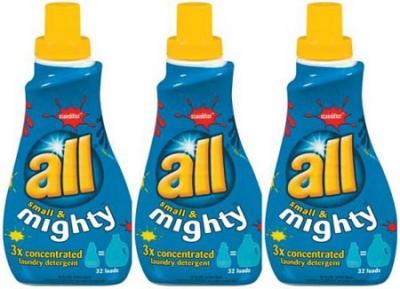Wal-Mart Stores Inc. announced an enormous change in its liquid detergent stocking policies recently, asserting that by May 2008, the company will stock its U.S. shelves with only concentrated versions of liquid laundry detergent as an effort to save water, plastic and cardboard. The Web site, MarketWatch’s analysis indicated that it was “a move that could radically change the strategies of manufacturers.â€
Wal-Mart estimates that the move will save 400 million gallons of water in the production process, 95 million pounds of plastic resin, 125 million pounds of cardboard and conserve 520,000 gallons of diesel fuel over the next three years. The fact is that the detergent manufacturers had already begun producing the concentrated products and Wal-Mart decided to take full advantage of that trend as part of its much wider green initiative.
Nevertheless, the implications of an announcement like this are enormous and far reaching because when the largest U.S. Corporation begins to think in these important ways – limiting unnecessary water consumption, and limiting the use of non-biodegradable- or slow to degrade packaging, which is a major issue in landfills, the marketplace is bound to sit up and take notice.
Clearly, this move by Wal-Mart will ultimately help to revolutionize the ways in which many other water-based products will be formulated and packaged to save both resources and massive amounts of money. Dedicated environmentalists can now hope that soon, many of those one-use, disposable “convenience†cleaning products that have proliferated in the marketplace in recent years, will lose both favor and market share.
While many consumers may have only begun saving power by grudgingly installing a few of those new-fangled light bulbs in their homes, local, state and federal government entities, important retailers like Wal-Mart, and now major manufacturers have been changing their approaches to going green in some amazingly radical ways. In fact, a slow and steady Green Revolution has been taking place in many sectors while the consumer has been largely asleep at the switch.
Consumers are only vaguely aware that the federal government has been ramping up their requirements of green building techniques and recycling procedures for all federal building projects for several years. Just a few of these include several EPA guidelines, USDA’s Biobased Purchasing Program, ENERGY STAR® and DOE Product Recommendations, as well as ASTM, LEED, Green Globes and other rating systems, standards and best practices.
In place since 2004, the Federal Green Construction Guide for Specifiers provides detailed information about every aspect of building processes in an effort to bring together all of the government’s project-specific environmental goals and mandates.
While many changes that have been occurring in the private sector have been on a voluntary basis, changing regulations by local, state and federal government bodies are becoming more widespread that will ultimately compel many more changes to greener standards.
To illustrate, Marin County, California has developed Green Building Residential Design Guidelines (pdf) for both new and remodeled homes that list every possible area imaginable, with a point system assigned to designate levels of importance that assist applicants for permits to comply with a wide variety of building codes. Categories include green building measures relating to site, foundation, structural frame, exterior finish, water efficiency, plumbing, electrical, appliances, roofing, insulation, windows and doors, HVAC, renewable and solar energy, indoor air quality, finishes, flooring, community design and innovation.
The home building and remodeling industries must be kept up to date on all the latest municipal requirements, or occupancy permits and tax credits are not granted. A remodeling job, recently completed in Marin County, that was effectively a total rebuild after a devastating fire, was not approved for occupancy until the correct low-flow toilets and a $1200 front-loading washing machine that requires minimal water were installed, and it was painstakingly determined that that the installation of the new EPA-approved wood-burning stove was up to code.
“Going Green†isn’t just for tree huggers anymore. It is quickly becoming a huge business as the vast pendulum swings from the extreme of tacit approval of squandered resources, back towards a unified understanding that now is the time to save the most basic raw materials like trees, and elements like clean water and air that are so vital for our very survival. And we don’t have a moment to waste!
The Author, Pamela Hepburn Fisk, is a writer for CalFinder Remodeling Contractors, a company that matches consumers with home improvements specialists and has recently been dedicating itself to educating the public about Green Rebuilding issues.
